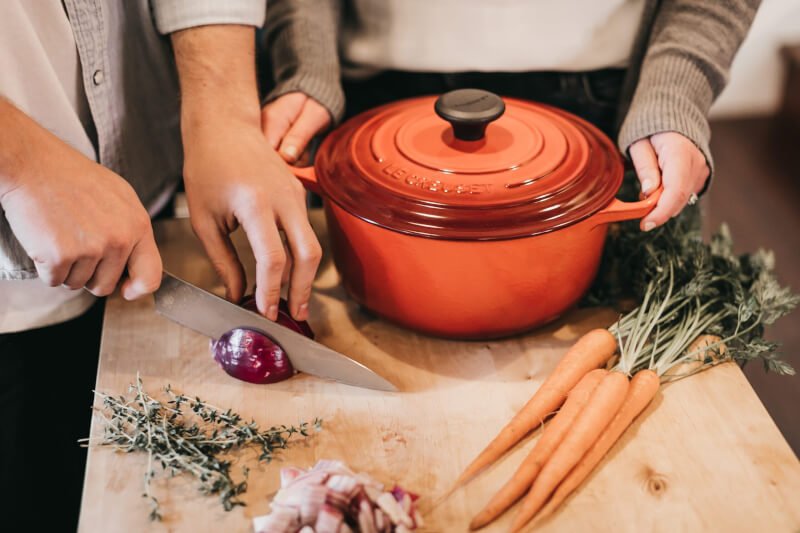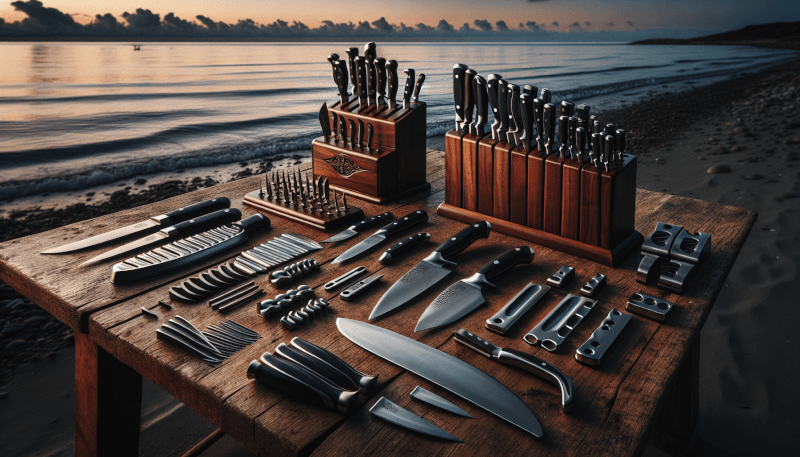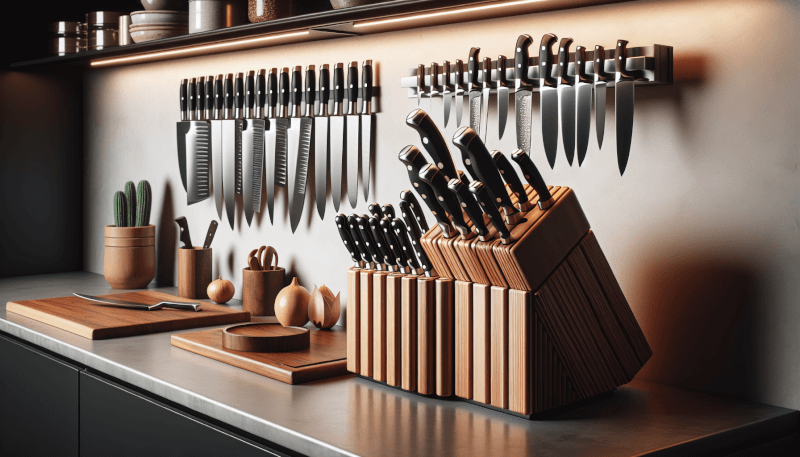If you are someone who loves cooking and takes great pride in your collection of kitchen knives, then you understand the importance of properly storing and protecting your knife blades from damage. Whether you have invested in high-quality chef’s knives or cherish a precious heirloom knife, it is crucial to ensure their longevity and sharpness. In this article, we will explore some practical tips and techniques to help you effectively store and protect your knife blades, allowing you to enjoy their slicing precision for years to come. From proper storage solutions to essential maintenance practices, we’ve got you covered. So, let’s dive in and discover the secrets to keeping your knife blades in pristine condition!
Choosing the Right Storage Option
Consider the Material
When it comes to storing knives, one of the first things you should consider is the material of your blades. Different blade materials require different storage methods to prevent damage. For example, stainless steel blades are less prone to corrosion, but they can still be damaged if not stored properly. On the other hand, carbon steel blades are more susceptible to rust and require extra care in storage. By considering the material of your knives, you can choose a storage option that will best protect them.
Choose a Sheath or Blade Guard
A sheath or blade guard is an essential accessory for knife storage. These protective covers offer a layer of defense against accidental cuts and scratches, protecting both the blade and yourself. When selecting a sheath or blade guard, ensure that it fits your knife securely to provide maximum protection. Whether you opt for a sheath made of leather, nylon, or plastic, having one will significantly reduce the risk of damage while your knives are stored.
Consider Wall Mounts and Magnetic Strips
If you’re looking for a convenient and space-saving storage option, wall mounts and magnetic strips are worth considering. Wall mounts allow you to display your knives while keeping them within reach. Magnetic strips, on the other hand, securely hold your knives in place using strong magnets, keeping them organized and easily accessible. These options work well if you have limited countertop space or if you want to showcase your prized collection.
Proper Cleaning and Drying
Clean After Every Use
To maintain the longevity and performance of your knives, it’s crucial to clean them after every use. A simple rinse with warm, soapy water is usually sufficient for most knives. However, remember to avoid using abrasive materials or harsh chemicals that can damage the blade. For stubborn food particles, a soft-bristled brush can be used to gently scrub the blade. Cleaning your knives immediately after use prevents the buildup of dirt, grime, and corrosive substances, ensuring they stay in pristine condition.
Dry Thoroughly Before Storage
Once your knives are cleaned, it’s important to thoroughly dry them before storing. Moisture left on the blade can lead to the formation of rust or corrosion, which can significantly damage the knife over time. To properly dry your knives, use a clean, lint-free cloth and wipe them down carefully. Pay extra attention to the handle and crevices where moisture tends to accumulate. By ensuring your knives are thoroughly dry, you’ll prevent any unwanted damage during storage.
Use Lubricants for Protection
To provide an extra layer of protection for your knives, you can consider using lubricants. Applying a thin coat of food-grade mineral oil or another knife-specific lubricant to the blade can help prevent rust and corrosion. These lubricants create a barrier against moisture, ensuring that your knives remain in top condition even during long periods of storage. Just remember to wipe off any excess lubricant before using the knife again to avoid transferring any residue to your food.

Avoiding Common Storage Mistakes
Avoid Storing Knives Loose
Storing knives loosely in drawers or containers without proper protection is a recipe for disaster. Not only can this lead to accidental cuts when reaching for other items, but it can also cause your knives to collide with each other, resulting in scratches and damage to their sharp edges. To avoid these issues, always use protective sheaths, knife blocks, or other storage options to securely hold each knife in place. By preventing contact between knives, you’ll maintain their sharpness and prevent unnecessary damage.
Don’t Store in a Damp Environment
Moisture is one of the biggest enemies of knife blades. Storing knives in a damp environment, such as a humid kitchen or basement, can promote the development of rust and corrosion. To prevent this, make sure your storage area is dry and well-ventilated. Avoid storing knives near sinks, dishwashers, or areas with high humidity levels. By keeping your knives in a dry environment, you’ll protect them from damage and ensure their longevity.
Avoid Stacking Multiple Knives
While it may seem convenient to stack multiple knives together for storage, it’s best to avoid this practice. Stacking knives can cause the blades to rub against each other, leading to scratches and dulling of the edges. Additionally, it increases the risk of accidental cuts when reaching for a specific knife. Instead, opt for storage options that allow each knife to be stored separately, such as knife blocks, trays, or magnetic holders. By providing individual spaces for each knife, you’ll protect their cutting edges and minimize the risk of injuries.
Safe Storage Options
Knife Blocks or Storage Trays
Knife blocks and storage trays are classic and practical storage options for home kitchens. Knife blocks usually have individual slots to securely hold each knife, preventing them from coming into contact with each other. Storage trays provide a similar function but may offer more flexibility in terms of size and organization. Both options allow you to keep your knives within easy reach while protecting their blades and ensuring their longevity.
Knife Rolls or Cases
For those who prefer to transport their knives or have a portable storage solution, knife rolls or cases are an excellent choice. These options typically consist of a fabric or leather roll that can be easily rolled up or folded to keep your knives safe and organized. Knife rolls and cases often have individual pockets or compartments to securely store each knife, preventing them from moving around during transport. Whether you’re a professional chef or an avid home cook, knife rolls or cases provide a convenient and protective storage solution.
Magnetic Knife Holders
Magnetic knife holders offer a modern and stylish storage option for knives. These holders feature powerful magnets embedded in a strip or block, allowing your knives to attach securely to the surface. By storing your knives vertically, magnetic holders minimize contact between knives, reducing the risk of damage. Additionally, they create a visually appealing display, showcasing your knives as a statement piece in your kitchen. Magnetic knife holders are particularly popular among chefs and cooking enthusiasts looking for easy access to their knives.

Storage Tips for Different Types of Knives
Chef’s Knives
Chef’s knives are a versatile and essential tool for any cook. To properly store a chef’s knife, it’s recommended to use a knife block or storage tray. Ensure that the knife is placed in a slot or compartment that fits its size, preventing any rubbing or contact between other knives. If you prefer a more accessible option, a magnetic knife holder can securely hold your chef’s knife while allowing quick and easy access whenever you need it.
Serrated Knives
Serrated knives, with their unique toothed edges, require special care when it comes to storage. Storing them in a knife block or storage tray with individual slots is the best option to prevent the serrated edges from coming into contact with other knives or surfaces. This helps maintain their sharpness and prevents any bending or damage to the teeth. When storing serrated knives, pay close attention to the depth of the slots or compartments to ensure they fit properly and are protected.
Boning Knives
Boning knives, with their slender and flexible blades, require specific storage considerations. Opt for a dedicated knife sheath or blade guard that is designed to accommodate the shape and size of a boning knife. These sheaths or guards often have a slimmer profile to match the blade’s shape, providing optimal protection and preventing accidental cuts. Additionally, storing boning knives separately from other knives helps preserve their delicate edges and maintain their overall performance.
Protective Measures During Travel
Use Blade Guards or Knife Sleeves
When traveling with your knives, it’s crucial to protect them from potential damage. Blade guards or knife sleeves are essential accessories to ensure the safety of your knives during transport. These protective covers provide a barrier between the blade and other items in your bag, reducing the risk of accidental cuts or scratches. Whether you’re heading to a friend’s dinner party or going on a culinary adventure, always use blade guards or knife sleeves to keep your knives secure and protected.
Pack Knives Separately
To further minimize the risk of damage during travel, it’s best to pack your knives separately from other items in your bag. This prevents your knives from shifting and coming into contact with hard objects or other utensils that could potentially dull or chip the blades. If possible, consider using a dedicated knife case or roll to ensure your knives are individually wrapped and stored securely in a compartment designed for their protection.
Carry-On or Checked Baggage?
When it comes to air travel, it’s essential to understand the regulations regarding carrying knives in your baggage. Knives are generally not allowed in carry-on luggage due to security concerns. Therefore, it’s important to pack your knives in checked baggage, ensuring they are securely stored to prevent any damage during handling. Always double-check the airline’s guidelines before traveling to avoid any surprises at the airport.

Sharpening and Maintenance
Maintain Sharpness with Honing
Regular maintenance is essential to keep your knives in optimal cutting condition. Honing is a process that helps realign the edge of a knife’s blade, keeping it sharp and effective. Using a honing steel or sharpening rod, gently swipe the blade at a 20-degree angle, starting from the base to the tip, on each side. This process helps remove any microscopic bends or misalignments on the edge, keeping your knife sharp and ready for use. Honing should be done before each use or as often as necessary, depending on your knife’s usage.
Store Properly After Sharpening
After sharpening your knives, it’s important to store them properly to maintain their newly restored sharpness. Just like after regular cleaning, make sure the blades are thoroughly dry before storing to prevent any moisture-related damage. If using a knife block or storage tray, ensure that the blades are properly housed in their designated slots or compartments. By storing your sharpened knives correctly, you’ll prolong their sharpness and minimize the need for frequent sharpening.
Avoid Excessive Force While Cutting
Using excessive force while cutting can cause unnecessary stress on the blade and result in damage over time. Let the sharpness of your knife do the work for you, applying only the necessary pressure to glide through food effortlessly. Avoid twisting or bending the blade, as this can lead to chips or even broken tips. By using proper cutting techniques and allowing the knife to do the work, you’ll not only prevent damage but also ensure safer and more efficient food preparation.
Safe Handling Practices
Avoid Cutting on Hard Surfaces
To protect both your knives and your countertops, it’s best to avoid cutting directly on hard surfaces like ceramic plates, granite, or marble. These surfaces can damage the blade and dull the edge faster than cutting on wooden or plastic cutting boards. Invest in high-quality cutting boards made of wood or plastic, as they are more forgiving on the knife’s edge. By using cutting boards, you’ll not only protect your knives but also prolong the life of your countertop.
Use Cutting Boards
Cutting boards are an essential tool in any kitchen and provide a safe and stable surface for food preparation. When selecting a cutting board, opt for materials that are knife-friendly and won’t dull the blade prematurely. Wooden and plastic cutting boards are excellent choices, as they are gentle on the knife’s edge and easy to clean. Avoid using glass or stone cutting boards, as they can cause damage to the blade. By using cutting boards, you’ll ensure the longevity of both your knives and your countertops.
Proper Knife Techniques
Using proper knife techniques not only helps ensure your safety but also prolongs the life of your knives. Always hold the knife with a firm grip and position your fingers away from the blade and in a curled position. This grip provides stability and reduces the risk of accidental cuts. When slicing or chopping, use a rocking motion with the blade, keeping the tip of the knife in contact with the cutting board. By practicing proper knife techniques, you’ll improve your efficiency in the kitchen while minimizing the potential for accidents and injuries.

Preventing Accidental Injuries
Store Knives Out of Reach of Children
When it comes to knife safety, it’s crucial to keep them out of reach of children. Ensure that your storage options are secure and elevated, preventing easy access for curious little hands. Knife blocks, magnetic holders mounted high on the wall, or locked cabinets are all effective ways to ensure the safety of your children. Educate your children about the dangers of sharp objects and emphasize the importance of never touching or playing with knives without adult supervision.
Always Close Folding Knives Properly
If you use folding knives, always make sure to close them properly after use. Leaving a folding knife open can lead to accidents, as the sharp blade is exposed and poses a significant risk. Develop the habit of closing the knife immediately after finishing your task and store it in its designated sheath or pocket. By closing folding knives properly, you’ll protect yourself and others from accidental cuts and keep the knife in good working condition.
Never Catch Falling Knives
It may seem instinctive to try and catch a falling knife to prevent it from hitting the ground, but this is a dangerous practice. Trying to catch a falling knife increases the risk of accidental cuts and serious injury. Instead, step back and let the knife fall freely onto a soft surface, such as a cutting board or towel. This prevents any harm to yourself and minimizes the chance of damage to the knife, allowing you to safely assess the situation and proceed with caution.
Educational Resources for Knife Care
Online Tutorials and Videos
The internet is a vast resource for learning about knife care. Numerous websites and video platforms offer tutorials and guides on various aspects of knife care, including proper storage, cleaning techniques, and sharpening methods. Take advantage of these resources to expand your knowledge and gain insights from experts in the field. They can provide step-by-step instructions and helpful tips to ensure you’re taking the best care of your knives.
Knife Maintenance Books
For those who prefer a more comprehensive and in-depth approach to knife care, books dedicated to knife maintenance can be a valuable resource. These books cover a wide range of topics, including different blade materials, storage options, sharpening techniques, and general maintenance tips. They often provide detailed instructions accompanied by illustrations and photographs to help you understand and implement proper knife care practices. Consider investing in a reputable knife maintenance book to have a valuable reference guide at your fingertips.
Local Cooking Schools or Cutlery Shops
If you prefer a hands-on approach to learning about knife care, local cooking schools or cutlery shops may offer workshops or classes on the subject. These establishments often have knowledgeable instructors who can provide demonstrations and answer any questions you may have. Attending such workshops allows you to interact with professionals and fellow enthusiasts, gaining practical skills and insights that can greatly benefit your knife care routine. Check with your local cooking schools or cutlery shops to see if they offer any knife care workshops or classes.
By following the tips and guidelines outlined in this comprehensive article, you’ll be well-equipped to store and protect your knife blades from damage. Remember to choose the right storage option, clean and dry your knives properly, avoid common storage mistakes, and prioritize safe handling practices. With the right knowledge and care, you can ensure that your knives remain sharp, functional, and ready to assist you in all your culinary endeavors.



